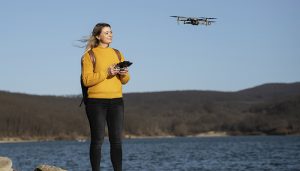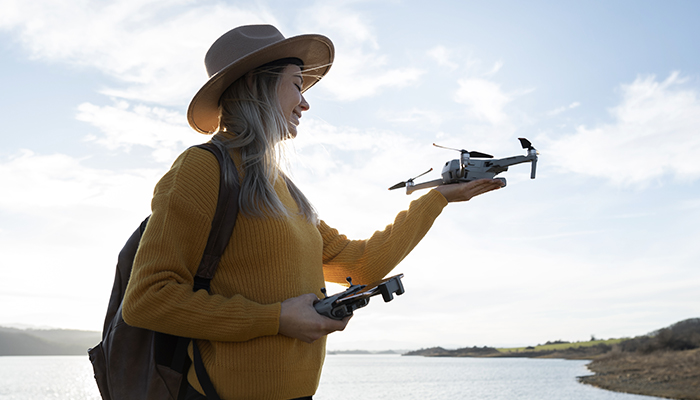Drones have transformed various industries. A single rotor drone is an uncrewed aerial vehicle with a big main rotor and a smaller tail rotor for stability and control. Single rotor drones are designed more advanced like traditional helicopters. They are noted for their high efficiency and capacity to transport larger cargoes. Single rotor drones may operate effectively in harsh situations and travel great distances due to their powerful lift and energy efficiency. You need better skills to operate the single rotor drone. Continue reading the blog to know a wide range of information on single rotor drones.
How Does a Single Rotor Drone Work?
Single rotor drones use numerous smaller propellers that are designed and operated like those of traditional helicopters. It is mostly used by surveyors and construction professionals. It can carry upto 40 kgs. The single rotor drone can fly faster than multi-rotors.
The primary rotor is important to a single rotor drone. This big spinning provides the lift to propel the drone off the ground. The aerodynamic principle of airfoils causes the rotor to create lift as it spins. This rotor is paired with an engine to drive the complete flight system.
The drone rotates in the opposite direction when the primary motor spins due to the force generated. Single rotor drones employ a tail rotor to reduce this impact. The tail rotor is installed vertically at the end of the boom. This prevents the force and stabilizes the drone by allowing it to hover steadily and spin smoothly in the desired direction.
The controlling pitch of the rotor blades accomplishes flight control in a single rotor. This is referred to as collective and cyclic pitch control. Collective pitch equalises the angle of all blades by controlling vertical motion.
The cyclic pitch varies the angle of each blade as it spins by allowing the drone to tilt and move forward, backward, and sideways. Drones with a single rotor are used in various fields like agriculture and surveying. They are more stable and effective than multi-rotor drones. But they need advanced abilities and piloting skills.
Components of Single Rotor Drones

It is crucial to analyze the primary components of a single rotor drone and their interactions during flight to understand how it operates.
-
Main Rotor
The main rotor is the primary part of a drone. It generates lift easily. The single rotor pushes air down by developing an upward force that propels the drone into the air when the air spins. The advanced models modify the angle of the rotor blade to determine how much lift is generated.
-
Tail Rotor
The tail rotor prevents the circulatory force generated by the main rotor. The tail rotor generates a rotational force that causes the body of the drone to spin in reverse when the primary rotor spins. The tail rotor stops this spin while controlling yaw.
-
Flight Controller
The single rotor drone comes with enhanced flight control features. This onboard computer controls stabilisation and GPS navigation.
-
Engine
The propulsion mechanism of drones may be combustion-based or electrical-based. It is completed based on its type. Larger single rotor drones frequently use the combustion engines to extend their flight duration.
-
Landing Gear
Drones are stabilised during take-off and landing using landing gear. The high-end models have retractable landing systems to cut down on drag.
Mechanics Of Single Rotor Drones
-
Anatomy and Components
A single rotor drone features a central rotor positioned at the top. This rotor spins by enabling the drone to fly. There is also a smaller rotor on the tail. The tail rotor prevents the drone from spinning in circles. The essential components of a single rotor drone are the rotor blades and batteries. People use a remote control to operate the drones.
-
Working Principles
When you turn on a single rotor drone, the motor starts. The engine makes the rotor blades spin fast. When the blades spin, they push the air down. This makes the drone rise and fly. The tail rotor helps steer the drone. So, when you want the drone to go left or right, the tail rotor moves it that way.
-
Controlling System and Stability
Single rotor drones commonly use gyroscopes and accelerometers in an onboard flight controller to ensure stability. These sensors allow the flight control to automatically modify the tail rotor power and rotor blade pitch by detecting the changes in velocity and direction. Swashplate system is a mechanical arrangement that modifies blade angles during rotation. It is incorporated into certain advanced models to provide precise maneuverability. A remote transmitter that transmits live signals to control altitude, pitch, and roll is used by pilots to operate the drone.
Tips For Flying a Single Rotor Drone
Learn to Hover
Practice a steady hover at a low altitude. Gaining proficiency in hovering helps you become more sensitive to control and prepares you for increasingly difficult movements.
Check the Weather
Since single rotor drones are more susceptible to gusts than multi-rotor drones. Hence, it is advisable to avoid flying in severe weather conditions. The best safety and control are offered on calm days.
Balance the Weight Properly
Make sure the drone is balanced evenly. Small weight imbalances can greatly impact the motor’s strain and flight stability.
Maintain a Battery and RPM
Drones with a single rotor consume significant power. To prevent mid-flight malfunctions, always fly with a fully charged battery and monitor your RPM levels closely.
Keep a Safe Flight Zone
Fly in broad spaces away from people, trees, and electrical wires. This increases signal reliability and lowers the chance of collisions.
Bottom Line
You should have a clear idea of single rotor drones and their tips for high efficiency. Drones with a single rotor are a potent class of uncrewed aerial vehicles that are excellent at endurance, efficiency, and weight carrying. Despite being more complicated and possibly hazardous than their multirotor counterparts, their skills make them essential in a wide range of professional domains. Single rotor drones will become a widespread option as helicopter drones continue to evolve in the future. Know its uses and use it wisely for better outcomes!

